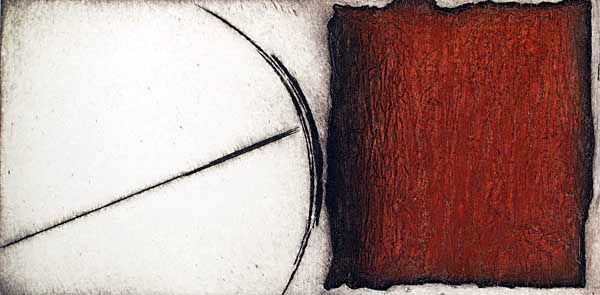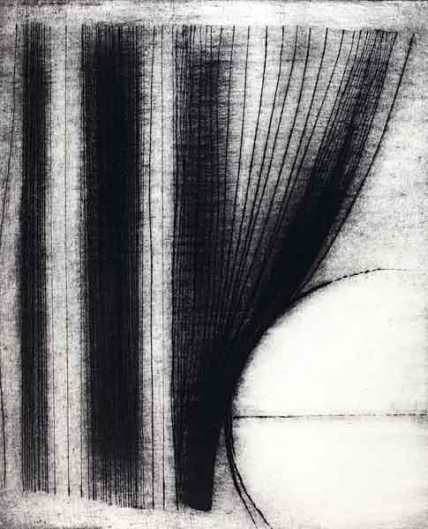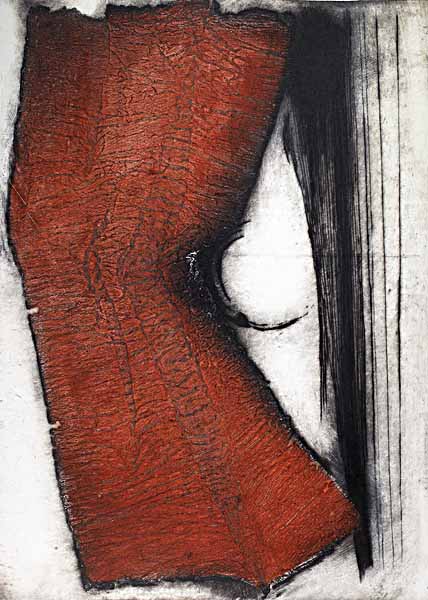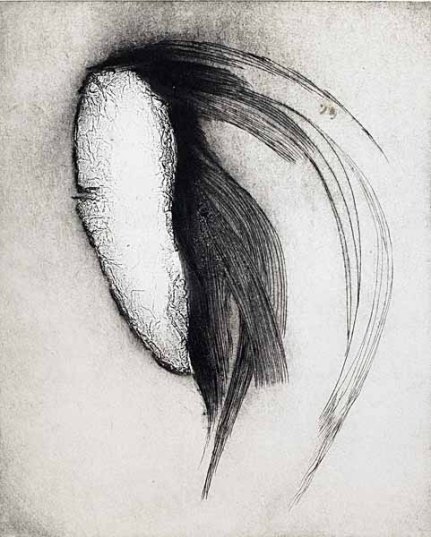There are works of art that engage the viewer right away. You look, you see a tree and you think you got it. They might, however, lack mystery or an impulse that triggers your imagination. Romana Rotterova’s unique prints with circles, curves and velvety lines offer you just that – a mysterious story of quietly intense perception.
My dear friend Alena Laufrova is a curious creature interested in making things of her own as well as exploring the creative world of others. She writes for Grapheion, the only Czech outlet (only online and only in Czech) dedicated to the art of printmaking, where you can read her interviews with renowned Czech artists and printmakers, focusing on (and challenging) their relationship to and with printmaking. She let me translate and post this short introduction of works by one of them, little known in the US sculptor and printmaker Romana Rotterova.
Original text by Alena Laufrova | It is fascinating to observe and study the development of an artist‘s expression, the way they mature and approach their work. Czech printmaker Romana Rotterova just celebrated her 80th birthday. Her prints are in the collections of such institutions as MoMA New York or the National Museum of Women in the Arts in Washington D.C., and have been showcased in more than 20 solo exhibitions and in international exhibitions in Belgium, Germany, Canada and the USA. A recent retrospective of her works, prints and drawings, only confirmed her position among the Czech leading printmakers, including Adriena Simotova, Alena Kucerova or Nadezda Synecka.
Everyone’s path is interesting and unique: from sculpture to printmaking
A native of Prague, Rotterova (b.1931) originally studied sculpture, first with her father, sculptor Leonard Rotter, and later with Vienna-born Mary Duras and painter V. J. Zizka. As a child, she spent a great deal of time in her father‘s sculpture studio, hoping to follow in his footsteps. Her health, however, did not allow her to pursue these early dreams, and instead Rotterova began making prints.
She was 32 when she discovered the unimaginable and endless possibilities offered by intaglio printmaking. A late bloomer one could say, yet one who immediately blossomed in this medium. Since the 1960s, Rotterova has focused exclusively on printmaking, which became her greatest adventure and life’s journey. Soon in that journey, Rotterova began experimenting with different ways to wipe ink off the metal plate. Using cloth to only partially clean the plate, while intuitively leaving some areas wiped clean and leaving others spread with ink, became her signature. The resulting unique quality of each print completely reflects her mode of expression, unveiling lines, thick and thin, solid and trembling. In addition to intaglio, she has mastered dry point technique, mostly black and white but sometimes complemented with a bold color accent.
One can see a resemblance of Rotterova’s work to the generation born in the 1930s and sometimes identified as the generation of New Sensitivity for their new approaches to art that became apparent in the 1960-1970s in Czechoslovakia. This period was an atmosphere of relative freedom after the heavily-oppressive Stalinist regime of the 1950s. At that time, Czechoslovak printmaking was booming with experiments in techniques and materials, moving towards complete abstraction. Rotterova has nevertheless remained independent of bigger trends. She consistently expresses her feelings, experience, dreams, as well as her own perception of reality through simplified, symbolic shapes such as circles and curves. There is point, structure, plane, and the play of light and shadow. The content of her prints is not straightforward – she communicates her messages through symbols, giving the viewer clues such that they become a traveler on a quest to unveil her mystery. Rotterova’s prints are meditative, quiet poems.
Everything has a beginning, everything has an end
Many artists go through phases of creative endeavors during their lifetime. Their signature changes as their language of expression develops. It is often assumed that artistic experience relates to self-improvement. Indeed, some artists gradually mature in their work. Some, though, create their best work when they are young. Romana Rotterova found her own artistic form, her themes and way of execution in the beginning, as soon as she started her experiments in printmaking. Her artistic path has been direct, without major changes, and is a testimony of person and artist with strong beliefs.
Every work of art finds a viewer
Some works of art engage viewers right away; they relate to them – art work to the viewer, viewer to the art work. To some extent, the connection depends on a viewer’s experience and education. Realistic symbols aren’t a mystery for the viewer. Rotterova’s prints share with the viewer something that is not depicted directly. One must step beyond the realm of the literal to engage in communication with her prints – to search for the undisclosed and read between the lines, to get absorbed and search inside oneself for buried memories and feelings.



